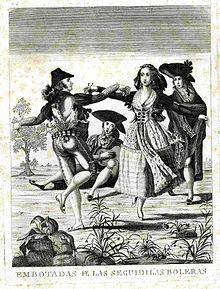Seguidilla

The seguidilla (
The term is also used for a Spanish stanza form with four to seven short, partly assonant lines in a characteristic rhythm.[1][2]
Types
The earliest and most influential of the types of seguidilla are thought to originate in either La Mancha or Andalusia, having become typical of large parts of central Spain. Variants include the seguidilla manchega (from La Mancha) as well as the murciana from Murcia and the slightly faster sevillana of Seville. One of the most complex styles of seguidilla is the seguidilla flamenca or seguiriya), which is used in flamenco music. Act I of Jacques Offenbach's opera La Périchole includes a number entitled "Séguedille".
Dance
The dance is performed in pairs with animated footwork reflecting the rhythm of the guitar and percussion, yet restrained upper body movement. One technique characteristic of the dance is known as bien parado, wherein the dancers stop motion at the end of a section of the music or stanza of text while the instruments continue playing into the next section. Usually the woman dancer also holds castanets.
Act I of ballet Don Quixote (classical version choreographed by Marius Petipa and restaged by Alexander Gorsky) includes a Seguidilla dance performed by corps de ballet.
Song
In general, seguidilla folksongs begin with a brief instrumental introduction, often played on guitar, followed by a salida, which is a small portion of the song text acting as a false start. The remaining sections are free and varied, consisting of instrumental interludios and the vocal sections called coplas.
The 'Seguidilla' in opera
An original song entitled Seguidilla occurs in Act I of the
Notes
- ^ a b c "seguidilla". Merriam-Webster.com Dictionary.. Accessed May 2008.
- ^ a b c Random House Dictionary
- ^ "seguidilla". Lexico UK English Dictionary. Oxford University Press. Archived from the original on March 22, 2020.
- ^ Aria database Seguidilla ("Près des ramparts de Séville"). Accessed March 2008
- ^ Julian Budden The Operas of Verdi, Vol. 3, p. 68

